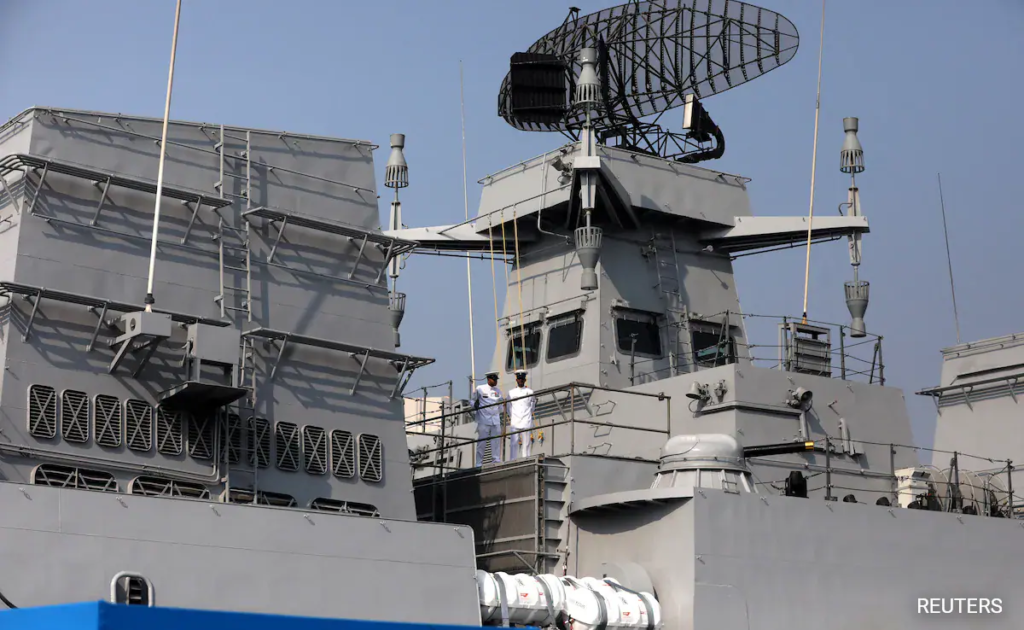Indian Navy’s Strategic Response
Indian Navy’s-Introduction:
Indian Navy’s-In a dramatic turn of events, an Indian warship is rapidly closing in on a hijacked vessel in the vast expanse of the Arabian Sea, signaling a critical moment in maritime security. The unfolding situation has captured global attention, prompting speculation and concern about the well-being of the ship’s crew, the motivations behind the hijacking, and the Indian Navy’s strategic response. In this comprehensive exploration, we delve into the unfolding events, examining what is known so far, the geopolitical implications, and the intricate details of the Indian Navy’s mission.

I. The Hijacking Incident:
The hijacking of a commercial vessel in the Arabian Sea has sent shockwaves through the international maritime community. Reports suggest that a group of armed pirates seized control of the ship, diverting it from its intended course and endangering the lives of the crew on board. The exact circumstances surrounding the hijacking remain unclear, with various sources providing conflicting information about the identity and motives of the perpetrators.
II. The Targeted Ship:
Details about the hijacked vessel have been limited, with authorities keeping a tight lid on specific information to avoid jeopardizing ongoing operations. However, it is known that the ship is a commercial vessel, likely engaged in transporting goods or resources through one of the world’s busiest maritime routes. The hijackers’ choice of target raises questions about the selection criteria and potential implications for global trade and security.
III. Geopolitical Implications:
The Arabian Sea, situated at the crossroads of major international shipping routes, has long been a focal point for geopolitical interests. The hijacking incident adds a new layer of complexity to an already delicate situation in the region. As India takes decisive action to address the crisis, neighboring nations and international partners are closely monitoring the developments, mindful of the potential ripple effects on regional stability and maritime security.
IV. Indian Navy’s Response:
The Indian Navy’s immediate response to the hijacking has been swift and calculated. A warship has been deployed to intercept and neutralize the threat posed by the hijackers. The details of the naval operation, including the specific vessel involved, the number of personnel deployed, and the tactics employed, are shrouded in secrecy to ensure the safety and success of the mission. The Indian Navy’s track record in combating maritime threats instills confidence in its ability to handle such crises effectively.
V. International Cooperation:
The hijacking incident underscores the importance of international cooperation in addressing maritime security challenges. India, as a key player in the region, is likely to coordinate efforts with neighboring countries and international partners to secure the safe release of the hijacked vessel and its crew. The incident serves as a stark reminder of the need for collaborative strategies and information-sharing mechanisms to combat piracy and other maritime threats effectively.
VI. Maritime Piracy in the 21st Century:
While piracy may seem like a relic of the past, the hijacking incident in the Arabian Sea highlights the persistent threat of maritime piracy in the 21st century. Despite advancements in technology and increased naval presence, pirates continue to exploit vulnerabilities in shipping lanes, posing a threat to global trade and the safety of seafarers. Governments and international organizations face the ongoing challenge of adapting strategies to counter evolving tactics employed by pirates.
VII. Ensuring Crew Safety:
Amid the intense focus on the geopolitical and strategic aspects of the hijacking, it is crucial not to lose sight of the human element involved. The safety and well-being of the crew on the hijacked vessel are paramount. The international community, including organizations such as the International Maritime Organization (IMO), must work collectively to ensure a safe and swift resolution to the crisis, minimizing harm to the individuals caught in the crossfire.
VIII. Future Implications:
The outcome of the ongoing crisis in the Arabian Sea will undoubtedly have far-reaching implications for maritime security, regional stability, and international cooperation. Depending on the resolution, it may influence future strategies employed by nations to counter maritime threats and shape policies aimed at safeguarding vital shipping routes. The incident serves as a critical case study for refining and improving global responses to emerging security challenges in the maritime domain.
Conclusion:
As the Indian warship closes in on the hijacked vessel in the Arabian Sea, the world watches with bated breath, aware of the potential ramifications of the unfolding crisis. The incident underscores the enduring threat of maritime piracy, prompting a reevaluation of global strategies to ensure the safety of shipping lanes and the protection of seafarers. The Indian Navy’s decisive response and international cooperation will play pivotal roles in determining the resolution of this high-stakes situation. As events continue to unfold, stakeholders must remain vigilant, prioritizing both the strategic imperatives and the human dimension of the crisis at hand.
